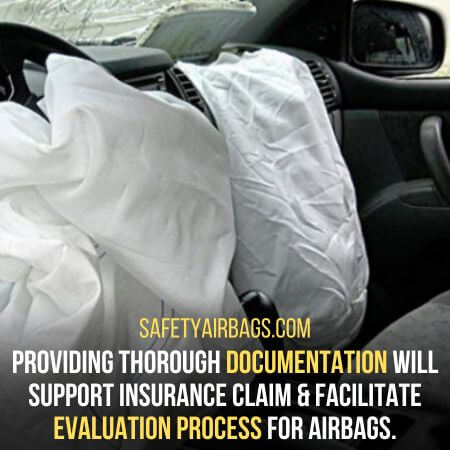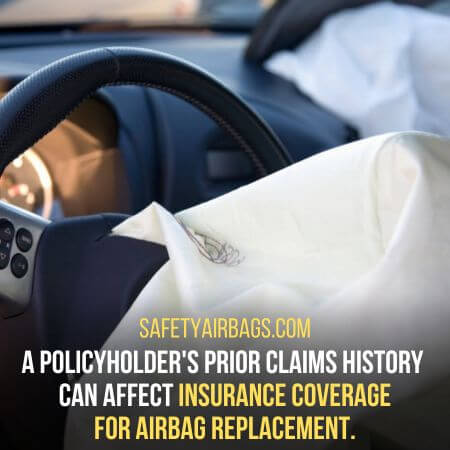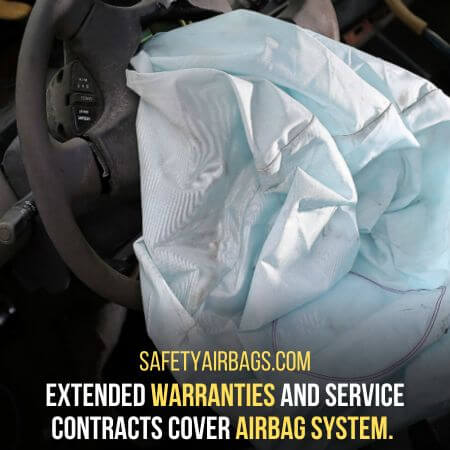Does insurance cover airbag replacement? Whether insurance covers airbag replacement depends on the specific policy and coverage options chosen by the policyholder.
What Will I learn
- 1 Does Insurance Cover Airbag Replacement? Understanding The Procedure
- 2 Evaluating Insurance Coverage for Airbag Replacement
- 3 Understanding the Claims Process
- 4 Factors Affecting Insurance Coverage for Airbag Replacement
- 5 Steps to Maximize Insurance Coverage for Airbag Replacement
- 6 Alternative Coverage Options for Airbag Replacement
- 7 Conclusion:
It is recommended to contact the insurance provider directly to inquire about coverage for airbag replacement and any additional requirements for filing a claim.
Does Insurance Cover Airbag Replacement? Understanding The Procedure
Auto insurance policies provide coverage for various aspects of vehicle-related damages and injuries.
Auto insurance policies are contracts between policyholders and insurance companies.

They provide financial protection against potential losses resulting from accidents or other incidents involving their vehicles.
These policies typically include multiple types of coverage to address different aspects of vehicle-related damages and injuries.
Types of Coverage Related to Airbag Replacement:
Regarding airbag replacement, it is important to understand the different types of coverage offered by auto insurance policies and any limitations or exclusions that may apply.
Types of coverage related to airbag replacement include collision coverage, comprehensive coverage, medical payments coverage.
The availability and extent of coverage may vary depending on the specific insurance policy and its terms and conditions.
1. Collision Coverage:
Collision coverage is designed to cover damages to the insured vehicle resulting from a collision with another object, such as another vehicle, a stationary object, or a pothole.
In the context of airbag replacement, collision coverage may cover the costs associated with deploying and replacing the airbags if they are damaged in a covered collision.
2. Comprehensive Coverage:
Comprehensive coverage protects against damages to the insured vehicle caused by events other than collisions.
This includes damages from theft, vandalism, fire, natural disasters, falling objects, and animal collisions.
If the airbags are deployed or damaged due to a covered comprehensive event, the comprehensive coverage may cover the costs of replacing the airbags.
3. Medical Payments Coverage:
Medical payments coverage, also known as MedPay, provides coverage for medical expenses resulting from injuries sustained in a covered accident.
If the deployment of airbags causes injuries to the vehicle occupants, medical payments coverage may help cover the medical costs associated with those injuries.
Evaluating Insurance Coverage for Airbag Replacement
When assessing insurance coverage for airbag replacement, it is essential to thoroughly review policy documents.
Also. contact the insurance provider, and understand the claims process.
1. Reviewing Policy Documents:
Policyholders should carefully read their insurance policy documents to understand the terms and conditions that govern their coverage.
Look for specific sections related to airbag replacement, including any coverage exclusions or limitations.
1.1 Coverage Details and Limitations:
Pay close attention to the coverage details outlined in the policy documents.
Note any specific coverage limits, deductibles, or requirements that may apply to airbag replacement.
Understanding these details will provide insight into the extent of coverage provided by the policy.
2. Contacting the Insurance Provider
Reach out to the insurance provider and speak with an agent or representative who can provide clarification regarding the coverage for airbag replacement.
Explain the situation and ask specific questions about the policy’s coverage, deductibles, and any documentation requirements.
2.1 Inquiring about Coverage for Airbag Replacement:
During the conversation with the insurance provider, inquire about the specific coverage for airbag replacement.
Ask whether the policy covers the cost of airbag deployment and replacement, as well as any potential limitations or conditions that may apply.
Understanding the Claims Process
If the airbags in the insured vehicle have deployed and require replacement, policyholders should initiate the claims process with their insurance provider.
Follow the necessary steps outlined by the insurance company to file a claim promptly.
Providing Necessary Documentation:
Gather all relevant documentation required for the claim process. This may include:
– A police report
– Photographs of the accident scene and the deployed airbags
– Repair estimates, and
– Any medical records related to injuries caused by the airbag deployment.

Providing thorough documentation will help support the claim and facilitate the evaluation process.
Working with Adjusters and Appraisers:
After filing the claim, an insurance adjuster or appraiser will likely be assigned to evaluate the damages and determine the coverage for airbag replacement.
Cooperate with them and provide any additional information or evidence they may request.
Their assessment will play a vital role in determining the insurance coverage for airbag replacement.
Factors Affecting Insurance Coverage for Airbag Replacement
Several factors can influence insurance coverage for airbag replacement.
Understanding these factors will help policyholders navigate their insurance claims more effectively and determine the extent of coverage they may receive.
1. Type of Accident and Fault Determination:
The type of accident and how fault is determined can impact insurance coverage for airbag replacement.
If the policyholder is at fault for the accident, coverage may be available under their collision coverage.
However, if another party is at fault, the policyholder may need to file a claim against the at-fault party’s liability insurance.
2. Policy Coverage Limits and Deductibles:
Insurance policies typically have coverage limits, which represent the maximum amount the policy will pay for covered damages.
Policyholders should review their policy to understand the specific coverage limits that apply to airbag replacement.
Additionally, deductibles are the amount the policyholder must pay out-of-pocket before insurance coverage applies.
The deductible amount can affect the policyholder’s financial responsibility for airbag replacement.
3. Vehicle Value and Repair Costs:
The value of the insured vehicle and the cost of repairing or replacing the airbags can impact insurance coverage.
The cost of airbag replacement may exceed a certain threshold in relation to the vehicle’s value.
Then the insurance company may consider the vehicle a total loss rather than covering the repair costs.
4. Prior Claims History and Insurance Premiums:
A policyholder’s prior claims history can affect their insurance coverage for airbag replacement.
Multiple previous claims or a history of at-fault accidents may result in higher insurance premiums or policy exclusions.

Policyholders with a clean claims history may be more likely to receive coverage for airbag replacement.
5. Policy Endorsements and Additional Coverage Options:
Policy endorsements and additional coverage options can impact insurance coverage for airbag replacement.
Some insurance policies may offer specific endorsements or add–ons that provide enhanced coverage for airbag deployment and replacement.
Policyholders should review their policy documents to understand if any additional coverage options are available to them.
Steps to Maximize Insurance Coverage for Airbag Replacement
To maximize insurance coverage for airbag replacement, policyholders can take certain steps to ensure they have adequate protection and documentation.
1. Reviewing and Updating Insurance Policies:
Regularly review insurance policies to ensure they provide sufficient coverage for airbag replacement.
Consider any changes in vehicle value, policy terms, or coverage options. If necessary, make updates or adjustments to the policy to align with current needs.
2. Maintaining Accurate Records and Documentation:
Maintain detailed records and documentation related to the vehicle, its maintenance, and any incidents involving airbag deployment.
This includes photographs of the vehicle’s condition, repair receipts, accident reports, and any relevant medical records.
Accurate documentation will support the insurance claim and help establish the need for airbag replacement.
3. Seeking Professional Advice and Assistance:
Seek advice from insurance professionals or consult with an insurance agent or broker.
They can provide valuable insights into policy coverage, exclusions, and limitations.
Their expertise can help policyholders navigate the claims process and ensure they receive the maximum insurance coverage for airbag replacement.
4. Understanding Policy Exclusions and Limitations:
Thoroughly understand the exclusions and limitations specified in the insurance policy.
This includes any specific conditions or events that may restrict coverage for airbag replacement.
Being aware of these exclusions will help policyholders manage their expectations and explore alternative coverage options if necessary.
Alternative Coverage Options for Airbag Replacement
In addition to standard insurance coverage, there are alternative options that policyholders can consider to supplement or enhance their coverage for airbag replacement.
1. Extended Warranties and Service Contracts:
Extended warranties and service contracts offered by vehicle manufacturers or third-party providers can provide additional coverage for airbag replacement. Y

These contracts often cover specific components of the vehicle, including the airbag system.
Policyholders should review the terms and conditions of these contracts to understand the extent of coverage and any associated costs.
2. Manufacturer Recall Programs:
If the airbags are subject to a manufacturer recall due to safety concerns, the manufacturer may provide free replacement as part of the recall program.
Policyholders should check with the vehicle manufacturer or the National Highway Traffic Safety Administration (NHTSA).
They need to determine if their vehicle’s airbags are subject to any recalls.
3. Supplemental Insurance Coverage:
Policyholders can explore supplemental insurance coverage options that specifically address airbag replacement.
Some insurance companies offer additional coverage riders or endorsements that can provide enhanced protection for airbag deployment and replacement.
These supplemental policies may have specific terms, conditions, and coverage limits, so it is important to review them carefully before purchasing.
By taking these steps and considering alternative coverage options, policyholders can maximize their insurance coverage for airbag replacement.
Being proactive, maintaining accurate records, and understanding policy details will help ensure that policyholders receive the necessary coverage to replace their deployed airbags.
Conclusion:
Insurance coverage for airbag replacement is determined by the policy terms, deductibles, and coverage limits.
It is important for policyholders to review their insurance policies, maintain accurate records, and understand the factors that can impact coverage.
By being proactive and exploring alternative coverage options, policyholders can maximize their insurance coverage for airbag replacement and ensure the safety of their vehicles and occupants.
